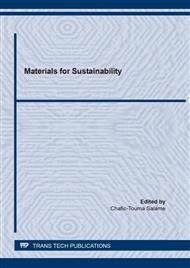p.41
p.51
p.65
p.81
p.95
p.103
p.115
p.125
p.135
Evaluating the Influence of Adding Natural Materials to Copper and Zinc Compounds
Abstract:
This article produced porous materials by using a simple and easy method which is a powder metallurgy. This search studying an experimental fulfillment on the thermal conductivity, apparent porosity, and Diametrical Strength of porous copper-zinc manufactured by the convert to carbon since firing process and combined with the oxygen cause to CO2 gas that rises up to air and leaves the number of pores. the basic metals are Cu and Zn pure powder metals with a different ratio (10-20-30)% of natural leaves especially palm leaves which is widely found in our natures, Cu fine powder (220 µm) has purity 99.5% as a matrix material to prepared composite material with ratio 80% of material total weight, 500g, Zn fine powder added as 20% from material total weight, the Zn metallic powder has purity 99.5%. The Zn powders have size particle less than200 𝜇m. Grounded palm leaves were cut to small parts then milled by using electrical mortar to get a fine powder which have a green size (less than 0.75 𝜇m) which result by sieving instruments. The results show various values in each test. In physical testing the apparent porosity from pure \Cu-Zn has 0.11%,10%0.187%,20% 0.22,30%0.32%,where the higher value for samples of palm leaves which has presence in a higher value in 30% of palm leaves, the others tests in thermal conductivity and diametric strength, in thermal conductivity have(5 W/m.k for pure material, in 10% 0.65 W/m.k, in20% 0.38 W/m.k,in 30% 0.2 W/m.k)for Cu-Zn-P.L composites these investigations show a decreasing ingredients especially in 30%, which have the lower value with the same effect in Diametrical Strength in pure samples has 25Mpa,in 10% has 10 Mpa, in 20%6Mpa,in30% 2.5Mpa.Generally the Optimum properties of Cu-Zn-P.L additives are attained with least porosity content. The existences of porosity decline the Diametrical Strength, thermal conductivity. Thus the aim of this study was to create porous composites metal MMC with has high attractive as an insulating material, and porous composites with natural additives.
Info:
Periodical:
Pages:
95-102
Citation:
Online since:
January 2022
Authors:
Keywords:
Price:
Сopyright:
© 2022 Trans Tech Publications Ltd. All Rights Reserved
Share:
Citation:


